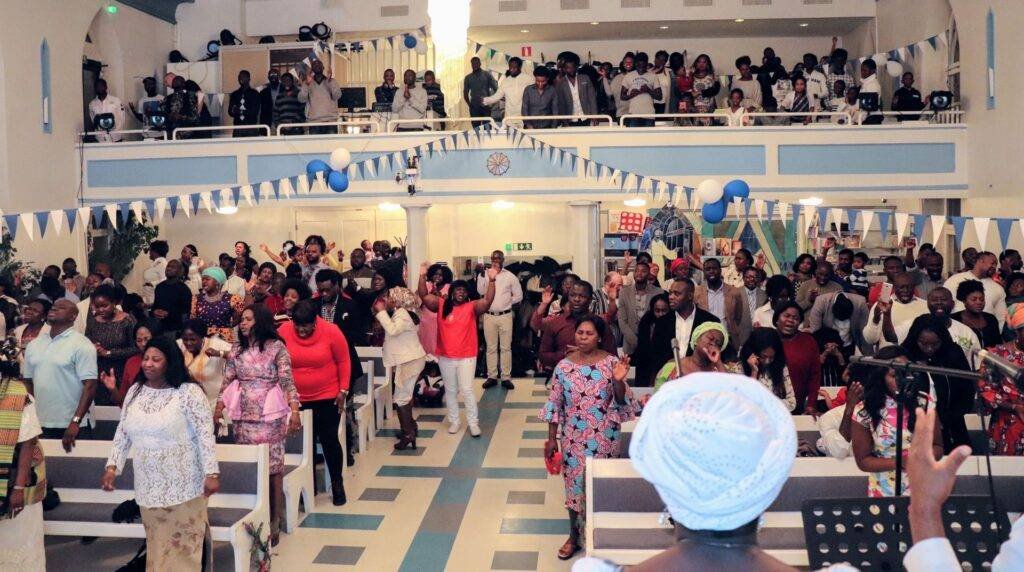Features
The second visit of Head of the Pentecost Church to Finland

Apostle Eric Nyamekye and wife
On Sunday, October 8, 2023, the Global Chairman of the Church of Pentecost, Apostle Eric Nyamekye, visited Finland. It was the second time he was in Finland.
His first visit about a year ago was to acquaint himself with the Pentecost Church in Finland, and spread the word of God.
This second visit of the Global Chairman was, therefore, a follow up to the mission of propagating the word of God as outlined in the first visit.


Apostle Nyamekye was accompanied by his dear wife, Mrs Mary Nyamekye.
They were hosted by the Church of Pentecost in Finland (COP Finland), led by its National Head, Apostle Francis Owusu Kwaah.
Powerful and inspiring ministration
In a well-attended church service patronised by other religious leaders from various churches or missions and dignitaries, Apostle Nyamekye preached a powerful message of spirituality, religious devotion and evangelism.
It was indeed an impressive occasion of powerful worship, ministration and spirit-filled songs of praise and under the theme, “Repositioning the local Church for maximum impact in the nations”.
Apostle Nyamekye sermonised on the greater need for Christians to be spiritually and morally upright for the greater glory of God. “Our greatest need is the understanding of the word of God”, he preached.
The Church leader also spoke about the Diaspora and building the Church of Pentecost in the world.
He asked for efforts to build a church that is multicultural, multiracial, encompassing various nationalities and diversity. To build and grow such an all-embracing church requires the efforts of the people themselves, he said.
The Pentecost Church in Finland
The Church of Pentecost in Finland was established about 20 years ago, in September 2000, as a prayer group with a small number of devoted persons in Helsinki (see www.copfinland. fi).
With time, following the growth of the group, there was the need to secure a place of meeting in the Helsinki area. Today, the Church has grown and spread to other towns and cities in Finland.
In Helsinki alone, there are two branches of the Church—the Akan Assembly where worship is done mostly in the Twi language, while the English Assembly (or the PIWC) where worship is done mostly in the English language. The other branch is attended by other nationalities, including African migrants, apart from Ghanaian migrants.
The COP Finland also has branches in the Finnish cities of Turku, Tampere, and Vaasa. There are other branches in Oulu and Kuopio.
In 2013, Apostle Edmund Appiah was posted to Finland as the National Head of COP Finland and there was growth during his term, including re-organising the Vaasa branch.
The growth of the Church has continued under Apostle Francis Owusu Kwaah, who took over from Apostle Appiah as the National Head of the Church in Finland a few years ago.
Expanding the Church
During his visit, Apostle Nyamekye met with leaders of COP in Finland, including the national executives, Elders, Deacons and Deaconesses, to discuss ways to expand the church in Finland and elsewhere.
There is undoubtedly a huge optimism about the efforts to spread the church in Finland, as can be perceived from the expression on the faces of the leaders and members of the Church, like Elder Charles Sarfo.
Finally, as I wrote previously, the COP Finland as one of the major Pentecostal or Charismatic churches dominated by Ghanaian migrants, has been a key channel through which the Ghana Union Finland (GUF), an association for the Ghanaian migrant community in Finland, reaches out to many members of the community. Thank you!
By Perpetual Crentsil
Email: perpetualcrentsil@yahoo.com
Features
Who knows tomorrow?
Recently a friend posted a sad news on his Facebook page, announcing the death of a school mate who had passed away, suddenly. The report had it that he was on his way to the airport to take a flight to Ghana.
I am sure this man had already informed the wife or a friend or a work colleague at work that he was returning home but he was not to return as a human being but as a dead body.
Such is life and so we need to be circumspect in how we go about things in life. The Bible reminds us that we are like grass which at one point in time looks elegant and the next moment becomes withered according to Psalm 90:5 and 6. It is for this reason that we need to guard our hearts with the word of God so that we shall be motivated to do the right thing, at all times.
This will enable us live on this planet, free from all sorts of troubles in our personal lives, even if we ignore the question of Heaven and Hell. Living a disciplined life delivers us from any kind of trouble as the Bible declares in Galatians 5:23 that against such there is no law.
The uncertainty surrounding our lives on earth is the more reason why people should commit their lives into the hands of the one who created it, in the first place unless you believe that the world created itself and that it appeared from nowhere.
Otherwise, the logical thing to do is to recognize the authority of the creator and surrender to his Lordship. Heaven is real and Hell is real, so for us who know the truth and have received Jesus as our Lord and Saviour, the onus lies on us to encourage our relations who have not believed and received Jesus into their lives, to do so.
We are a couple of days from another Easter Resurrection celebration and an opportunity to reflect on our lives in relation to the significance of Easter. In the Bible, the only occasion Jesus, Saviour of the world commands us to celebrate is his death and resurrection.
He never commanded his followers to celebrate his birth but like everything else, we chose to ignore Jesus’s instructions and decided to do what pleases us, just like our forefather and mother in the Garden of Eden.
Let us deliberately choose to do things differently as Christians this Easter, so we can really benefit from all the blessings that the celebration of the death and birth of Jesus, has on offer. Doing the same thing over and over and expecting a different result is definitely insanity.
I choose to be different this Easter and I am believing God for a newness of life so God’s glory would be revealed in me to draw the unsaved to him. It is only when people especially the unsaved, see the character of Christ in us, that they can be convinced about the authenticity of Jesus, as Saviour of the world, who can bring transformation in their lives too.
This is what would motivate them to surrender their lives to Jesus Christ. Let us make this Easter a memorable one that will be cherished for a long time. It is also a period for reconciliation and it would be great if in the spirit of Easter, we would try to reach out to those who have wronged us or have a grudge against us.
This would demonstrate that we have indeed accepted Jesus and that our religious posture is not a sham. May the good Lord grant us the grace to love our neighbours as ourselves, demonstrating the love of God in the process.
Those who have lost their loved ones and Easter brings sad memories, may the good Lord comfort and strengthen you. God bless.
.NB: ‘CHANGE KOTOKA INTERNATIONAL AIRPORT TO KOFI BAAKO INTERNATIONAL AIRPORT’
Features
Cosmetic deformities
COSMETIC deformities refer to physical imperfections or abnormalities that affect an individual’s appearance, often causing emotional distress and impacting their quality of life.
These deformities can be congenital, acquired, or result from various medical conditions or treatments. This article provides an in-depth exploration of cosmetic deformities, their types, causes, effects, and treatment options.
Types of cosmetic deformities
Cosmetic deformities can affect various parts of the body, including the face, skin, hair, nails, and teeth. Some common types of cosmetic deformities include:
1. Facial deformities: Congenital or acquired abnormalities affecting the shape, structure, or appearance of the face, such as cleft lip and palate, facial paralysis, or facial asymmetry.
2. Skin deformities: Conditions affecting the skin’s texture, tone, or appearance, such as acne, scars, birthmarks, or skin discoloration.
3. Hair deformities: Abnormalities affecting the hair’s growth, texture, or appearance, such as alopecia, hirsutism, or hair loss due to medical conditions or treatments.
4. Nail deformities: Conditions affecting the shape, size, or appearance of the nails, such as nail fungus, nail psoriasis, or nail trauma.
5. Dental deformities: Abnormalities affecting the shape, size, or appearance of the teeth, such as tooth decay, tooth loss, or malocclusion.
Causes of cosmetic deformities
Cosmetic deformities can result from various factors, including:
1. Genetics: Congenital conditions or inherited traits can cause cosmetic deformities.
2. Trauma: Injuries or accidents can result in cosmetic deformities, such as scars or facial trauma.
3. Medical conditions: Certain medical conditions, such as acne, psoriasis, or eczema, can cause cosmetic deformities.
4. Treatments and procedures: Medical treatments, such as chemotherapy, radiation therapy, or surgery, can result in cosmetic deformities.
5. Aging and environmental factors: Aging, sun exposure, and environmental factors can contribute to cosmetic deformities, such as wrinkles, fine lines, or age spots.
Effects of cosmetic deformities
Cosmetic deformities can have significant emotional and psychological effects on individuals, including:
1. Low self-esteem: Cosmetic deformities can lead to feelings of insecurity, self-consciousness, and low self-esteem.
2. Social anxiety: Individuals with cosmetic deformities may experience social anxiety, avoiding social interactions or feeling embarrassed in public.
3. Emotional distress: Cosmetic deformities can cause emotional distress, including depression, anxiety, or stress.
4. Impact on quality of life: Cosmetic deformities can affect an individual’s quality of life, impacting their relationships, career, or overall well-being.
Treatment options for cosmetic deformities
Various treatment options are available to address cosmetic deformities, including:
1. Surgical procedures: Surgical procedures, such as reconstructive surgery, cosmetic surgery, or dermatological surgery, can correct or improve cosmetic deformities.
2. Non-surgical treatments: Non-surgical treatments, such as laser therapy, chemical peels, or microdermabrasion, can address cosmetic concerns, such as skin texture, tone, or appearance.
3. Medical treatments: Medical treatments, such as topical creams, oral medications, or injectable treatments, can address cosmetic concerns, such as acne, hair loss, or nail deformities.
4. Prosthetic and orthotic devices: Prosthetic and orthotic devices, such as wigs, hairpieces, or dental prosthetics, can help individuals with cosmetic deformities.
5. Counselling and therapy: Counselling and therapy, such as cognitive-behavioral therapy or psychotherapy, can help individuals cope with the emotional and psychological effects of cosmetic deformities.
Conclusion
Cosmetic deformities can have significant emotional and psychological effects on individuals, impacting their quality of life and overall well-being.
Understanding the types, causes, and effects of cosmetic deformities is crucial in addressing these concerns.
Various treatment options are available, ranging from surgical procedures to non-surgical treatments, medical treatments, prosthetic and orthotic devices, and counselling and therapy.
By seeking professional help and support, individuals with cosmetic deformities can improve their appearance, boost their self-esteem, and enhance their overall quality of life.
Reference
1. “Cosmetic Deformities” by the American Society of Plastic Surgeons







